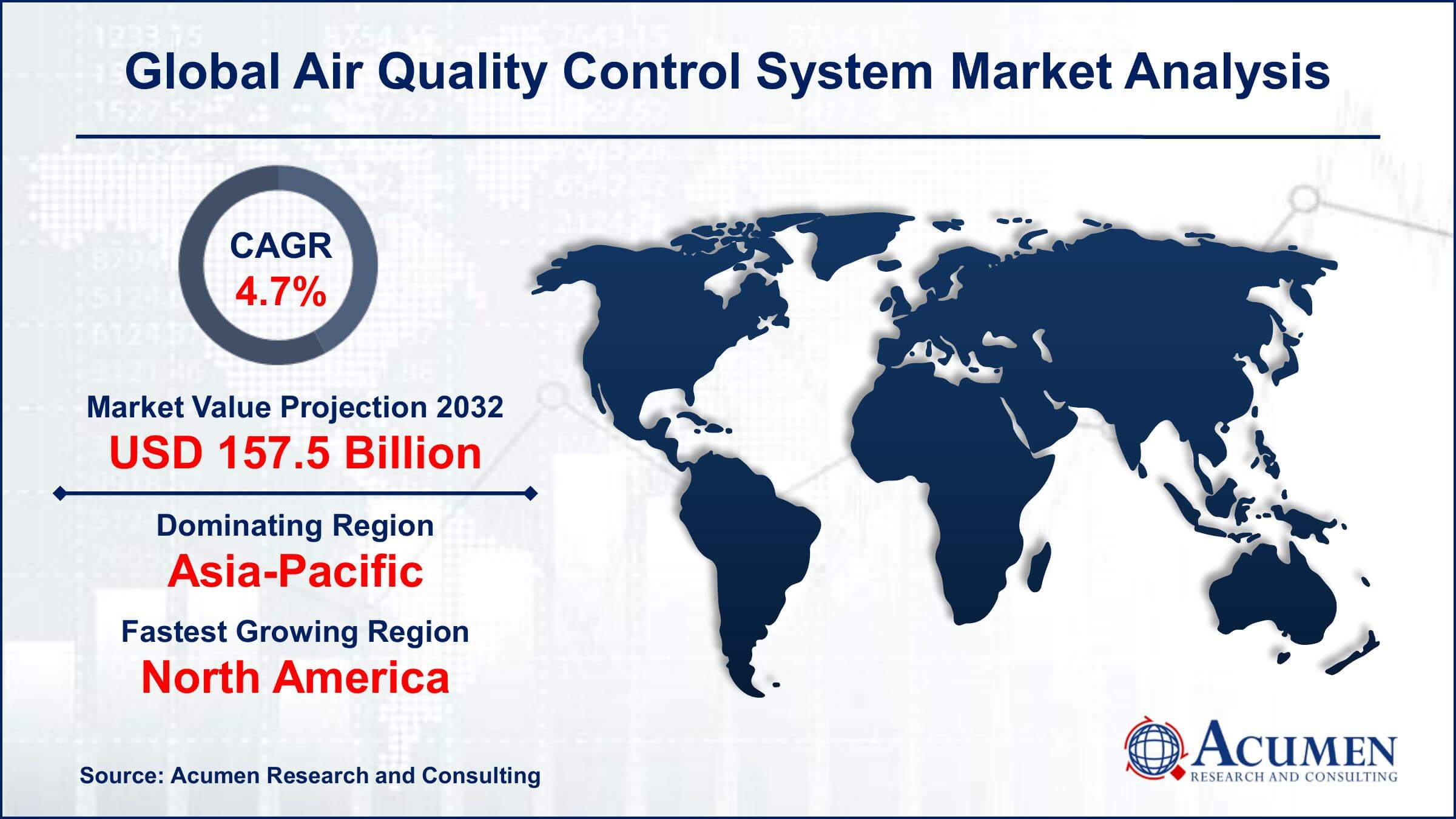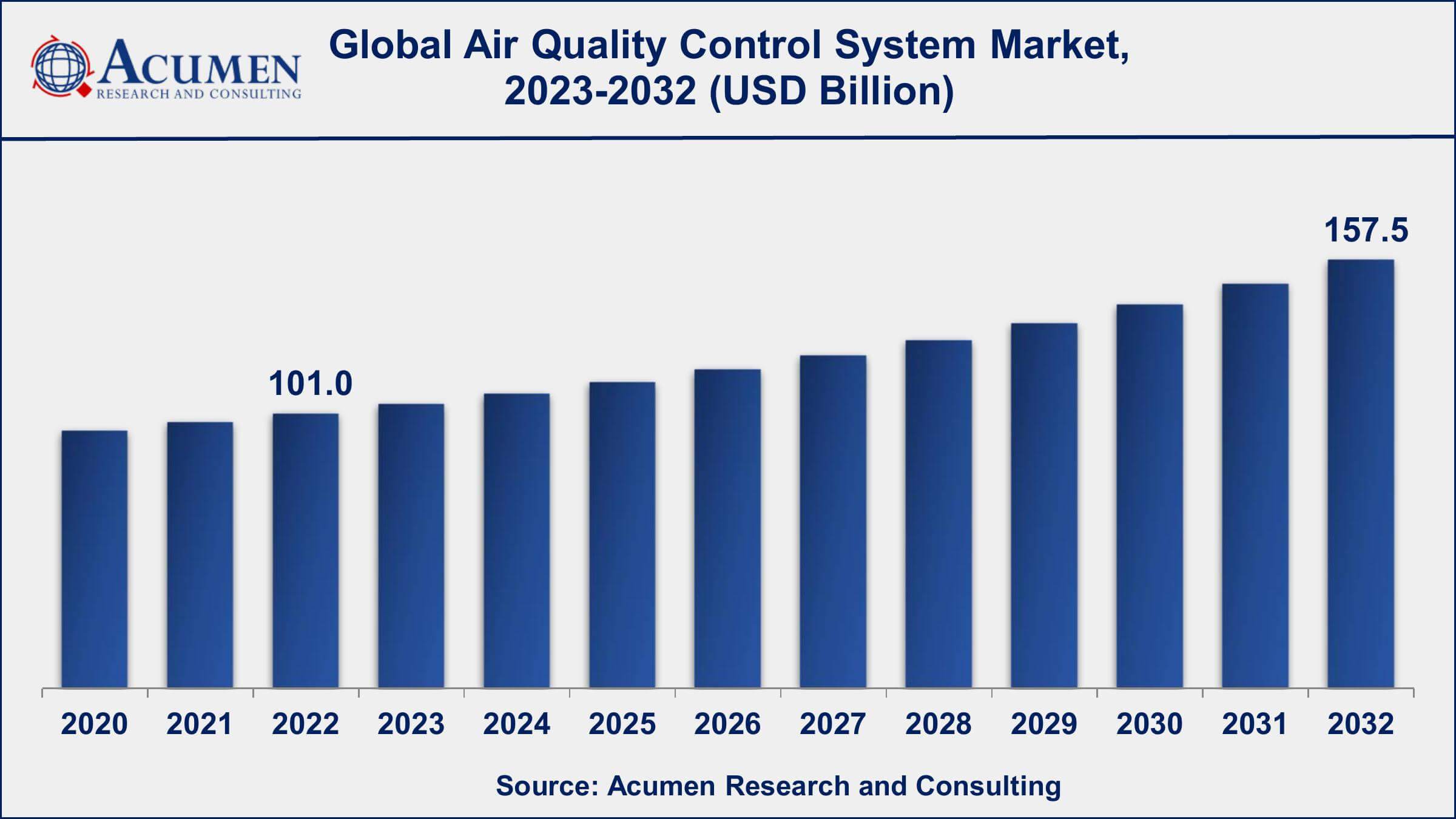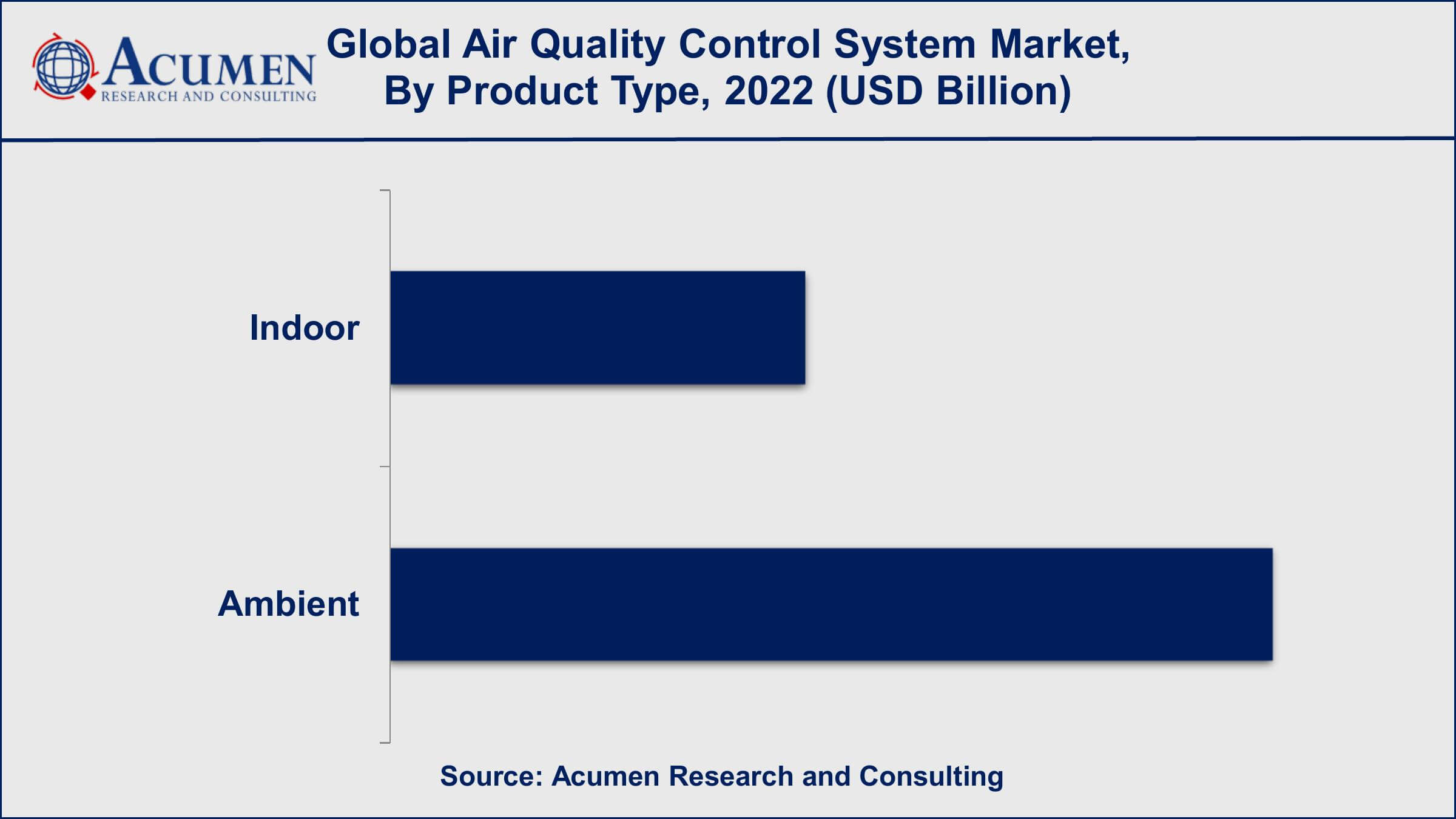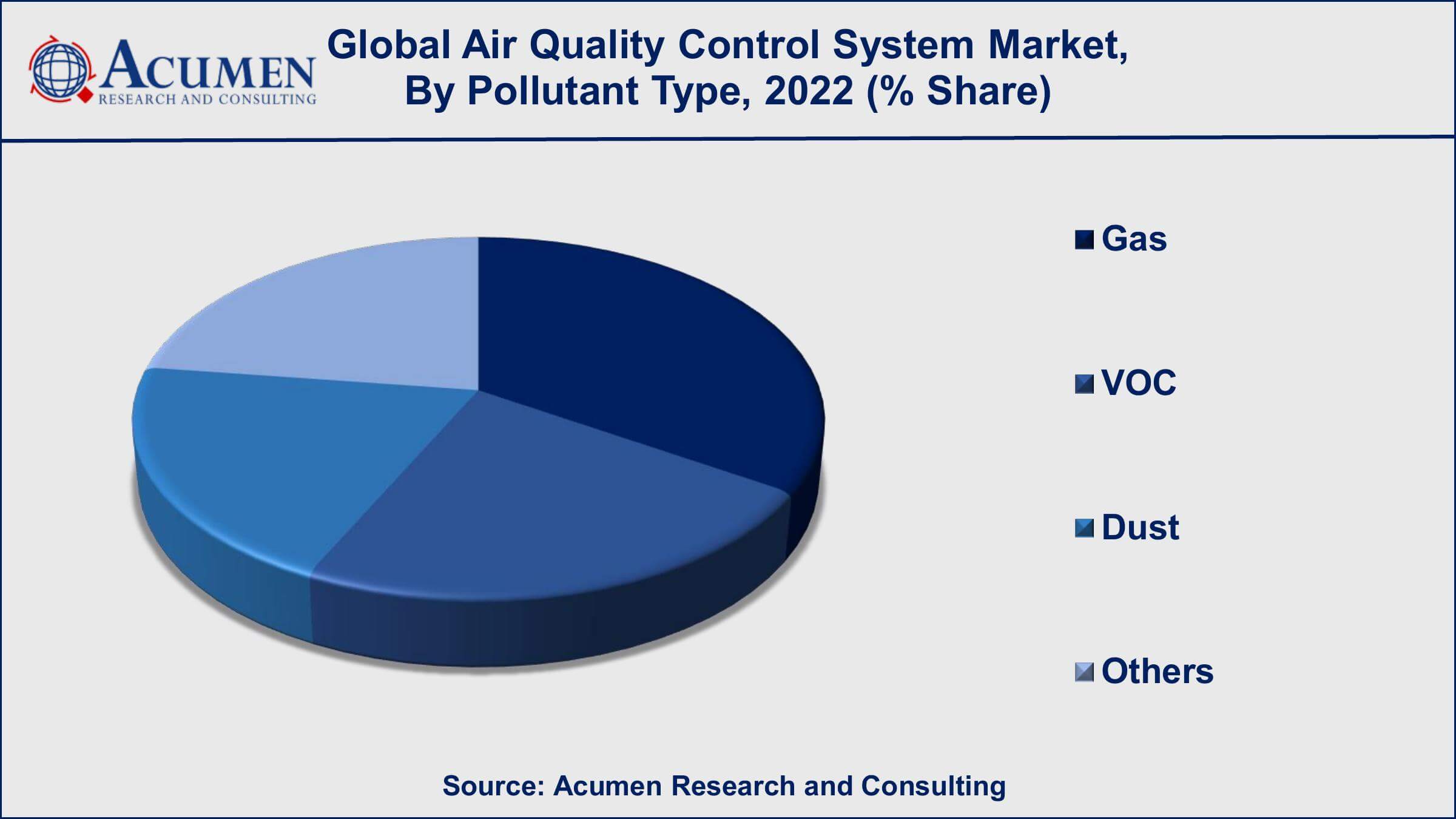October 2023
Air Quality Control System Market Size collected USD 101.0 Billion in 2022 and is set to achieve a market size of USD 157.5 Billion in 2032 growing at a CAGR of 4.7% from 2023 to 2032.
The Global Air Quality Control System Market Size collected USD 101.0 Billion in 2022 and is set to achieve a market size of USD 157.5 Billion in 2032 growing at a CAGR of 4.7% from 2023 to 2032.
Air Quality Control System Market Report Statistics

Harmful and toxic elements present in the air have severe evil effects on the health of individuals. These toxic elements include pollutants emitted from various industries such as cement manufacturing, power generation, oil and gas refining, and chemical processing among others. Currently, the pollutants emitted from automobiles are also creating increased environmental pollution. Maintaining proper air quality is an important factor in maintaining the healthy life of an individual. Rapid elimination of these pollutant gases from industries is of utmost essential. An air quality control system provides complete and efficient solutions for the proper treatment of these pollutant gasses and helps to release cleaner air. Owing to increasing environmental concerns, stringent regulations are implemented by the government with regard to the industrial emission of gasses. This, in turn, is anticipated to create a better opportunity for various air quality control system manufacturers.

Global Air Quality Control System Market Dynamics
Market Drivers
Market Restraints
Market Opportunities
Air Quality Control System Market Report Coverage
| Market | Air Quality Control System Market |
| Air Quality Control System Market Size 2022 | USD 101.0 Billion |
| Air Quality Control System Market Forecast 2032 | USD 157.5 Billion |
| Air Quality Control System Market CAGR During 2023 - 2032 | 4.7% |
| Air Quality Control System Market Analysis Period | 2020 - 2032 |
| Air Quality Control System Market Base Year | 2022 |
| Air Quality Control System Market Forecast Data | 2023 - 2032 |
| Segments Covered | By Product Type, By Pollutant Type, By Application, By End-User Industry, And By Geography |
| Regional Scope | North America, Europe, Asia Pacific, Latin America, and Middle East & Africa |
| Key Companies Profiled | Daikin Industries Ltd., Donaldson Company, Inc., Mitsubishi Hitachi Power Systems, Ltd (MHPS), Babcock & Wilcox Enterprises, Inc., Hamon Corporation, GEA Group Aktiengesellschaft, Thermax Ltd., GE Power, and Siemens AG. |
| Report Coverage |
Market Trends, Drivers, Restraints, Competitive Analysis, Player Profiling, Covid-19 Analysis, Regulation Analysis |
Air Quality Control System Market Growth Factors
Rapid growth in different industry verticals, especially iron and steel industries, cement industries, and manufacturing across the globe in order to meet the rising demand of consumers coupled with strict regulations imposed by the governments towards harmful gas emission is the key factor expected to boost the adoption of air quality control systems. Moreover, increasing demand for air quality control systems from various automotive manufacturers in order to eliminate greenhouse gas emissions and reduce pollution rate is also anticipated to trigger the demand for air quality control systems in coming years. In addition, the installation of air quality control systems in automotive gives a competitive advantage to the automotive manufacturers over other manufacturers owing to rapidly increasing environmental concerns.
Air Quality Control System Market Segmentation
The worldwide air quality control system market is categorized based on product type, pollutant type, application, distributional channel, and geography.
Air Quality Control System Market By Product Type

According to the air quality control system market forecast, ambient air quality control systems segment will account for the largest share in the market in recent years. Control systems for ambient air quality are used to monitor and control outdoor air pollution caused by sources such as transportation, power generation, and industrial processes. The growing awareness of the health effects of air pollution, as well as the implementation of stringent government regulations on air pollution control, are driving the growth of the ambient air quality control systems market. Indoor air quality control systems, on the other hand, are used to maintain good air quality in enclosed spaces such as homes, offices, and healthcare facilities. The growing emphasis on health and wellbeing, growing concerns about indoor air pollution and rising demand for energy-efficient buildings are driving the growth of the indoor air quality control systems market.
Air Quality Control System Market By Pollutant Type

In recent years, the gas pollution control systems segment has held the largest share of the market for air quality control systems. Gas pollution control systems are used to monitor and control harmful gases emitted by industries and transportation, such as carbon monoxide, sulphur dioxide, nitrogen oxides, and volatile organic compounds (VOCs). The increasing emphasis on reducing air pollution and the implementation of stringent government regulations on industrial emissions are driving the growth of the gas pollution control systems market. VOC control systems are used to reduce volatile organic compound emissions from a variety of sources, including paints, coatings, and adhesives. The growing emphasis on reducing the harmful effects of VOCs on human health and the environment is driving the growth of the VOC control systems market.
Air Quality Control System Market By Application
The automobile segment has held the largest share of the market for air quality control systems. Automobile air quality control systems are intended to reduce harmful gas emissions from vehicles. The increasing demand for cleaner and more fuel-efficient vehicles, the integration of stricter government regulations on vehicle emissions, and the increasing acceptance of the health effects of automobile air pollution are driving the growth of this segment. Industrial air pollution control systems are used to monitor and control harmful gas, volatile organic compound (VOC), and particulate matter emissions. The increasing emphasis on reducing industrial emissions, the implementation of tighter government regulations on industrial emissions, and the increasing awareness of the health effects of industrial air pollution are driving the growth of this segment.
Air Quality Control System Market By End-User Industry
According to an industry analysis of air quality control systems, the commercial and residential segment has the largest share of the air quality control systems market. To maintain good indoor air quality in buildings such as offices, hospitals, and homes, air quality control systems for commercial and residential applications are used. The increasing awareness of the significance of good indoor air quality, the growing demand for energy-efficient buildings, and the integration of stricter government regulations on indoor air quality are driving the growth of this segment. Transportation is another important end-use industry for air quality control systems, accounting for a sizable market share. Air quality control systems for automobiles, public transportation systems, and airports are included in this segment.
Air Quality Control System Market Regional Outlook
North America
Europe
Asia-Pacific
Latin America
The Middle East & Africa
Air Quality Control System Market Regional Analysis
Geographically, Europe accounted for the highest share in the air quality control system market owing to stringent government regulation towards pollution control in the region. However, the air quality control systems market in Europe is anticipated to experience a sluggish growth rate in the coming years due to already high market penetration. European market is followed by North America in terms of adoption of air quality control systems. On the other hand, Asia-Pacific region is expected to experience a promising growth in terms of revenue during the forecast period owing to the rapid growth in coal fired power generation sector.
Air Quality Control System Market Players
Some of the key players in the global air quality control system market include Daikin Industries Ltd., Donaldson Company, Inc., Mitsubishi Hitachi Power Systems, Ltd (MHPS), Babcock & Wilcox Enterprises, Inc., Hamon Corporation, GEA Group Aktiengesellschaft, Thermax Ltd., GE Power, and Siemens AG.
Looking for discounts, bulk pricing, or custom solutions? Contact us today at sales@acumenresearchandconsulting.com
October 2023
June 2024
June 2022
September 2023